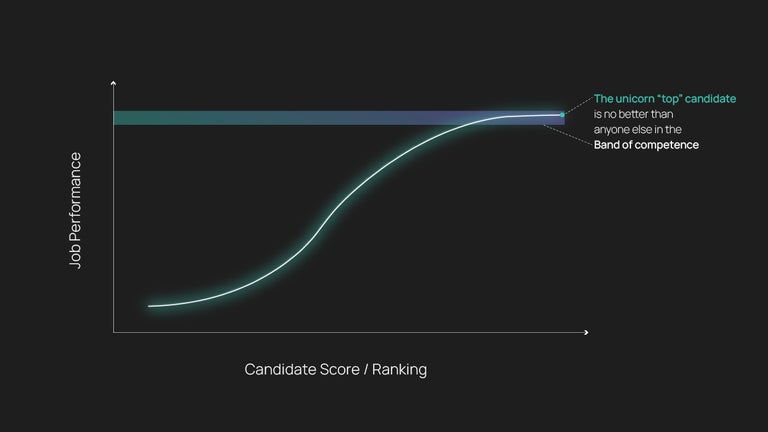Contents
- Imprecise Job Requirements
- Chasing “Top Candidates”
- Define Your Minimum Viable Skill Levels
- Putting It To Practice
Ask not if your candidate has more work experience than God. Ask if you really need someone who does.
If you are recruiting for a top secret operation that will determine the fate of the world, please ignore this post.
If not, we would like you to avoid the two cardinal sins of recruiting: imprecise job requirements and chasing “top” candidates.
Imprecise Job Requirements
Instead of focusing on the actual job, most hiring managers and recruiters focus on the job market, or their perception of it. They look at the market rate for a particular job title, determine if they want to undercut, match or beat it, and adjust their job requirements accordingly. Since they have not determined what skills the job itself requires or how they can predict candidates’ effectiveness, they switch to the most universally available proxies for a candidate’s market value: number of years of college or work experience.
These arbitrary filters result in self-rejections by a large number of potentially effective candidates.
Chasing “Top Candidates”
When candidates do apply to these ill-defined jobs, the second stage of arbitrary filtering happens till only “top” candidates remain. This has two potential problems
Since job requirements were vague in the first place, the criteria used to identify “top” candidates are imprecise too. In practice, recruiters and managers end up filtering by university (Stanford or bust), prior employer (entry level FAANG engineers > C-suite execs elsewhere), location or (luke)warm intros from their own personal networks.
More importantly, even if the criteria to determine “top” candidates happens to be correct, they are often too selective because they do not account for what we call the competence curve - a chart of job performance against candidate score or ranking.

When they think about selection at all, most managers treat their tests as though a higher score always results in better job performance. In practice, most test scores have a non-linear impact on job performance. Very low test scores do predict poor performance, but there is often a threshold above which job performance does not increase with the score.
Define Your Minimum Viable Skill Levels
The non-linearity of the competence curve has profound implications for “optimal” candidate selection. By chasing the “unicorn” top candidate, managers miss out on the large number of equally effective candidates in the band of competence.
Instead, we encourage employers to identify minimum viable skills and skill levels for each job. By definition, anyone who does not have these minimum viable skill levels is unqualified, even if they have a shiny PhD in string theory from Stanford. Conversely, all candidates who have these minimum viable skill levels are equivalent, and employers should hire any one of these and invest in their success, rather than chase irrelevant credentials.
Putting It To Practice
This is great fortune cookie advice, and we recognize it is fiendishly hard to define the minimum viable skills and skill levels for most jobs. For example, the minimum viable language level may be CEFR-C for a sales or tech support person, but only B2 for a developer. Likely, developers need higher programming aptitude than QC engineers, but the latter need more attention to detail.
At Crossover, we are creating a job builder wizard which will help you identify the minimum viable skills, and help search through the millions of workers with those skills. We base this on two insights :
- You should prioritize aptitude skills over acquired skills (since high-aptitude workers can acquire the latter), and
- You should verify candidates really do have the skills they claim to have.
We will explore more about this job builder wizard in future posts.







